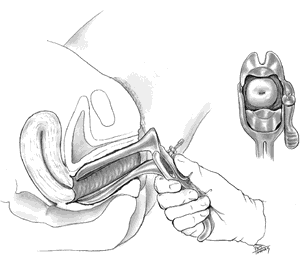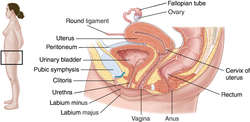Medical term:
vagina
vagina
[vah-ji´nah] (pl. vagi´nae)The interior lining of the vagina is mucous membrane; muscles and fibrous tissue form its walls. In pregnancy, changes occur in these tissues, enabling the vagina to stretch to many times its usual size during labor and childbirth. In a virgin, the opening of the vagina is usually, but not necessarily, partially closed by a membrane, the hymen. Usually the hymen breaks at first intercourse; occasionally it ruptures during physical exercise.
In a normal state, the lining of the vagina secretes a fluid that is fermented to an acid by the bacteria that are usually present. This acidity probably helps to protect the vagina from invasion by other organisms. Douching as a regular practice should not be employed except when recommended by a health care provider.
The patient lies on her back on a special table with her legs raised and spread by stirrups. The examiner inserts a speculum to spread the vagina open and thus is able to observe the cervix and the lining of the vagina directly, and may take smears for microscopic examination to detect infection or cancer of the vagina or cervix. (See also papanicolaou test.)
After removing the speculum the examiner inserts rubber-gloved fingers into the vagina and places the other hand on the abdomen. In this way it is possible to palpate the female reproductive organs, including the uterus and ovaries, between the hands. These organs are otherwise difficult or impossible to examine.
Ideally, a vaginal examination should be done between menstrual periods; however, vaginal bleeding is not a contraindication to this procedure. Patients should be told this so that they will not postpone an appointment for examination when vaginal bleeding persists. They should not take over the counter medications or douche immediately before a vaginal examination; douching might remove secretions that could be useful in diagnosis.

va·gi·na
, gen. and pl.va·gi·nae
(vă-jī'nă, -nē), Avoid the colloquial and jargonistic use of this word as a synonym of vulva.vagina
(və-jī′nə)vagina
The canal that extends from the labia and opening of the vagina to the uterine cervix.menopause
Change of life, climacteric, 'time of life' Gynecology The cessation of menstrual activity due to failure to form ovarian follicles, which normally occurs age 45–50 Clinical Menstrual irregularity, vasomotor instability, 'hot flashes', irritability or psychosis, ↑ weight, painful breasts, dyspareunia, ↑/↓ libido, atrophy of urogenital epithelium and skin, ASHD, MI, strokes and osteoporosis–which can be lessened by HRT. See Estrogen replacement therapy, Hot flashes, Male menopause, Premature ovarian failure, Premature menopause. Cf Menarche.va·gi·na
, pl. vaginae (vă-jī'nă, -nē) [TA]Synonym(s): sheath (1) .
vagina
(va-ji'na) plural.vaginae, vaginas [L., sheath]
Anatomy
In the uppermost part, the cervix divides the vagina into four small vaulted cavities, called fornices: two lateral, the anterior, and the posterior. The bladder and urethra are adjacent to the anterior wall of the vagina, and the rectum is behind the posterior wall. The cavity of the vagina is a potential space; the walls are usually in contact with each other. Close to the cervix uteri the walls form a horizontal crescent shape, at the midpoint an H shape, and close to the vulva the shape of a vertical slit. The vaginal mucosa is stratified squamous epithelium that is very resistant to bacterial colonization. This lining is in folds called rugae, and the connective tissue external to it also permits stretching. The blood supply of the vagina is furnished from the inferior vesical, inferior hemorrhoidal, and uterine arteries. Except for the area close to the entrance, the vaginal tissue and mucosa contain few, if any, sensory nerve endings. The vagina is a passage for the insertion of the penis, for the reception of semen, and for the discharge of the menstrual flow. It also serves as the birth canal.
artificial vagina
bulb of vagina
vagina fibrosa tendinis
foreign bodies in vagina
vagina masculina
Prostatic utricle.vagina mucosa tendinis
septate vagina
vagina
Literally a sheath. In the female it acts as a receptacle for the penis in coitus and as the birth canal. The vagina is a fibromuscular tube, 8–10 cm long lying behind the URINARY BLADDER and URETHRA and in front of the RECTUM. The cervix of the UTERUS projects into it upper part. The vagina is highly elastic and has a thickened and folded mucous membrane lining that can stretch readily.vagina
the portion of the female reproductive tract (OVIDUCT) of mammals into which the penis is introduced during copulation and through which the baby passes during birth.Vagina
vagina
[vah-ji´nah] (pl. vagi´nae)The interior lining of the vagina is mucous membrane; muscles and fibrous tissue form its walls. In pregnancy, changes occur in these tissues, enabling the vagina to stretch to many times its usual size during labor and childbirth. In a virgin, the opening of the vagina is usually, but not necessarily, partially closed by a membrane, the hymen. Usually the hymen breaks at first intercourse; occasionally it ruptures during physical exercise.
In a normal state, the lining of the vagina secretes a fluid that is fermented to an acid by the bacteria that are usually present. This acidity probably helps to protect the vagina from invasion by other organisms. Douching as a regular practice should not be employed except when recommended by a health care provider.
The patient lies on her back on a special table with her legs raised and spread by stirrups. The examiner inserts a speculum to spread the vagina open and thus is able to observe the cervix and the lining of the vagina directly, and may take smears for microscopic examination to detect infection or cancer of the vagina or cervix. (See also papanicolaou test.)
After removing the speculum the examiner inserts rubber-gloved fingers into the vagina and places the other hand on the abdomen. In this way it is possible to palpate the female reproductive organs, including the uterus and ovaries, between the hands. These organs are otherwise difficult or impossible to examine.
Ideally, a vaginal examination should be done between menstrual periods; however, vaginal bleeding is not a contraindication to this procedure. Patients should be told this so that they will not postpone an appointment for examination when vaginal bleeding persists. They should not take over the counter medications or douche immediately before a vaginal examination; douching might remove secretions that could be useful in diagnosis.

va·gi·na
, gen. and pl.va·gi·nae
(vă-jī'nă, -nē), Avoid the colloquial and jargonistic use of this word as a synonym of vulva.vagina
(və-jī′nə)vagina
The canal that extends from the labia and opening of the vagina to the uterine cervix.menopause
Change of life, climacteric, 'time of life' Gynecology The cessation of menstrual activity due to failure to form ovarian follicles, which normally occurs age 45–50 Clinical Menstrual irregularity, vasomotor instability, 'hot flashes', irritability or psychosis, ↑ weight, painful breasts, dyspareunia, ↑/↓ libido, atrophy of urogenital epithelium and skin, ASHD, MI, strokes and osteoporosis–which can be lessened by HRT. See Estrogen replacement therapy, Hot flashes, Male menopause, Premature ovarian failure, Premature menopause. Cf Menarche.va·gi·na
, pl. vaginae (vă-jī'nă, -nē) [TA]Synonym(s): sheath (1) .
vagina
(va-ji'na) plural.vaginae, vaginas [L., sheath]
Anatomy
In the uppermost part, the cervix divides the vagina into four small vaulted cavities, called fornices: two lateral, the anterior, and the posterior. The bladder and urethra are adjacent to the anterior wall of the vagina, and the rectum is behind the posterior wall. The cavity of the vagina is a potential space; the walls are usually in contact with each other. Close to the cervix uteri the walls form a horizontal crescent shape, at the midpoint an H shape, and close to the vulva the shape of a vertical slit. The vaginal mucosa is stratified squamous epithelium that is very resistant to bacterial colonization. This lining is in folds called rugae, and the connective tissue external to it also permits stretching. The blood supply of the vagina is furnished from the inferior vesical, inferior hemorrhoidal, and uterine arteries. Except for the area close to the entrance, the vaginal tissue and mucosa contain few, if any, sensory nerve endings. The vagina is a passage for the insertion of the penis, for the reception of semen, and for the discharge of the menstrual flow. It also serves as the birth canal.
artificial vagina
bulb of vagina
vagina fibrosa tendinis
foreign bodies in vagina
vagina masculina
Prostatic utricle.vagina mucosa tendinis
septate vagina
vagina
Literally a sheath. In the female it acts as a receptacle for the penis in coitus and as the birth canal. The vagina is a fibromuscular tube, 8–10 cm long lying behind the URINARY BLADDER and URETHRA and in front of the RECTUM. The cervix of the UTERUS projects into it upper part. The vagina is highly elastic and has a thickened and folded mucous membrane lining that can stretch readily.vagina
the portion of the female reproductive tract (OVIDUCT) of mammals into which the penis is introduced during copulation and through which the baby passes during birth.Vagina
Latest Searches:
Voraxaze - Voranil - Voorhoeve - voodoo - VOO - Vontrol - von - vomitus - vomiturition - vomitory - vomitoria - vomito - vomitive - vomiting - vomit - vomica - vomerovaginalis - vomerovaginal - vomerorostralis - vomerorostral -
- Service manuals - MBI Corp